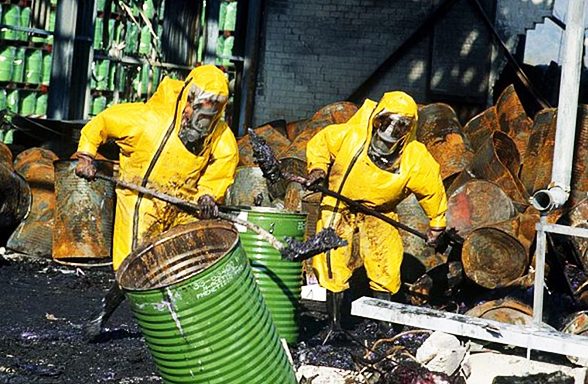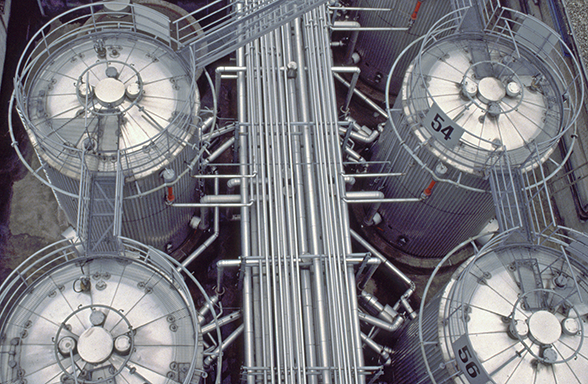Switzerland’s Ordinance on the Prevention of Major Accidents (MAO) establishes the basis for the cooperation of all affected actors in the area of major accidents prevention. During the drafting of the act, the authorities were able to take direction from models available in other countries. However the MAO goes one important step further: its provisions target not only stationary installations, but also transport and pipeline systems.

In the weeks that followed the fire, it was at the top of the political agenda - in both Switzerland and neighbouring countries to the north, which were equally affected by the accident. Federal Councillor Alphons Egli met the environment ministers of the Rhine riparian countries to discuss preventive measures and clarify eventual liability issues. Several institutions, among others the International Commission for the Protection of the Rhine (ICPR), were entrusted with the task of analysing the accident and studying its consequences.
Concrete measures
In addition, emphatic calls were made for the establishment of a legal framework in Switzerland, based on which precautionary measures could be imposed for the prevention of accidents involving dangerous substances. As early as 2 December 1986, the Federal Council appeared before the United Federal Assembly and declared that a major accidents ordinance was needed. Examples of such legislation already existed in other countries: a corresponding ordinance had been enacted in Germany in 1980 and the Council of the European Communities had passed the Seveso Directive on the Major Accident Hazards of Certain Industrial Activities in June 1982. The latter was enacted in response to an explosion in a chemical factory near the city of Seveso in 1976, which had released a cloud of highly toxic dioxin, and previous incidents, for example that in Flixborough in 1974 - which had highlighted drastic deficits in relation to inappropriate preventive measures and crisis management in chemical operations. Switzerland had added an article on such disasters to its Environmental Protection Act in response to the Seveso accident: however its relatively general formulation was not sufficient to provide a basis for the definition of concrete measures. "There were no directives and the cantonal authorities that could have implemented the corresponding precautionary measures were also lacking," explains Martin Merkofer, Head of the Major Accident and Earthquake Mitigation Section at the FOEN.
Switzerland's regulations go one step further: transport routes included
Within a short timeframe, which reflected the urgency of the issue, the Environmental Protection and Waters Protection Acts were supplemented by the Ordinance on Protection against Major Accidents (MAO), which entered into force on 1 April 1991. With the new ordinance, Switzerland not only rectified the legal deficit that existed in relation to major accidents prevention, it went even further. The provisions of the Major Accidents Ordinance prescribe lower thresholds for chemicals than the Seveso Directive and also cover transport routes, on which dangerous goods are transported, high-pressure gas and oil pipelines, and particularly dangerous microorganisms. Hence, in contrast to the corresponding German and Austrian legislation, the MAO is not limited to the regulation of stationary chemical installations. The transport of risky substances is also subject to the MAO regime.
Forewarned is forearmed
The hazard characteristics (toxicity, flammability and explosivity, and environmental risks) and the corresponding threshold quantities for substances and preparations are listed in the annex of the Major Accidents Ordinance. "The threshold quantities for less harmful substances are higher than those specified for dangerous, e.g. highly toxic, substances that can cause major damage even in small quantities," explains Martin Merkofer. "Thus, based on these criteria, the owners of establishments can identify whether their establishments are subject to the provisions of the MAO," reports the FOEN expert.
List of over 2,000 fundamentally dangerous substances
By way of support for this process, the FOEN compiled a list of threshold values for over 2000 substances. Hence those in charge of such establishments are required to assume responsibility for compliance with the legislation: they must report to the relevant cantonal inspection authorities and are obliged to undertake suitable risk minimisation measures that are feasible in terms of the available safety technology and economically viable. These preventive measures include, for example, regulations relating to storage, retention systems for any extinguishing water that may arise, and strategies for the better management of major accidents and for the alerting of the population.
Inspections based on a summary report and risk assessment
The authorities verify whether the obligation to take precautions is fulfilled. This process is divided into two stages: first, a summary report must be submitted which contains information about the nature, exact location and surroundings of the establishment and about the nature and quantity of the dangerous substances used there. If it is not possible to exclude the possibility of serious damage to the population or environment, a risk assessment must then be compiled, which estimates the scale of the possible damage to the environment and population and the probabilities of occurrence, and indicates the safety measures that have been taken to avoid this. The authorities then assess whether the risk is acceptable or whether additional safety measures must be implemented to minimise the risk, for example the installation of additional extinguishing water retention basins.

Different actors, different tasks
For their part, the cantons compile a risk register for their territories listing all of the establishments subject to the MAO. Based on this, the Swiss Risk Register (Eidgenössische Risikokataster ERKAS), which is compiled by the FOEN, provides an overview of all establishments that work with large quantities of dangerous substances or particularly hazardous microorganisms. "ERKAS is an element of the supervision carried out at federal level," explains Martin Merkofer. "It helps us to identify where the greatest risks are located, how they are evolving and the areas in which the implementation of the Major Accidents Ordinance should be concentrated. "
The importance of cooperating and exchanging experience
Hence the owners of establishments and plants that are subject to the MAO must take action on their own initiative. They can, of course, rely on the support of the federal and cantonal authorities: "For example, when new substances are included in the MAO, the enforcement authorities actively approach the establishments and corresponding guidelines are made available," explains Martin Merkofer. Considerable emphasis is placed on cooperating and exchanging experience in the area of major accident prevention: for example, the cantons have jointly developed two guidelines (Löschwasserrückhalt and Lagerung gefährlicher Stoffe), one on the storage of dangerous substances and one on the retention of extinguishing water.
Correct storage increases safety
Various precautions required by the MAO aim to ensure that risky situations do not arise in the first place. Accordingly, it stipulates that substances must be stored in a manner which takes "account of their properties" and that an up-to-date record of their stocks and locations must be maintained. This means for example that the storage of substances that could react dangerously with each other is not allowed; in addition, information about the stored substances must be available and rapidly accessible to the fire service and chemical emergency unit in the event of an incident. Where possible, dangerous substances must be replaced by less harmful ones or smaller quantities should be used. This reflects that also the quantity and not only the nature of a substance is relevant for the danger.
Building safe infrastructure helps too
Finally, the safety measures listed in the MAO also include structural precautions, for example the construction of separate fire compartments which can withstand fire for sufficient periods. "A warehouse like the one in Schweizerhalle, which was originally designed for the storage of machines and did not even have a sprinkler system, would definitely not be converted for chemical storage today. The regulations regarding storage and extinguishing water retention have changed drastically," notes Martin Merkofer.
Hence the safety measures for stationary installations based on the Major Accidents Ordinance principles have reduced the risks to human life and the environment to an acceptable level.

The chemical industry's commitment to safety
Serious accidents in the past 50 years have heightened the chemical sector's awareness of the need for preventive and safety measures.
The chemical industry also learned its lessons from the Schweizerhalle fire disaster. Major accidents generate considerable costs which bear no relation to those incurred by effective accident prevention. The reputational damage arising from the fire also motivated the sector to work harder on improving the safety of its plants. Chemical companies in Canada had already launched the Responsible Care initiative after the chemical accident of Bhopal (India) in 1984. The German and Swiss sectoral associations joined this initiative in 1991. Swiss companies that wish to become members of scienceindustries, the sectoral association of the chemical, pharmaceutical and biotechnology sector, are obliged to subscribe to the principles of Responsible Care. These largely correspond to the safety measures required by the MAO.
The chemical industry plays a crucial role in the implementation of the safety measures. In addition, its input is indispensable to the further development of the MAO.
Last modification 28.10.2016





